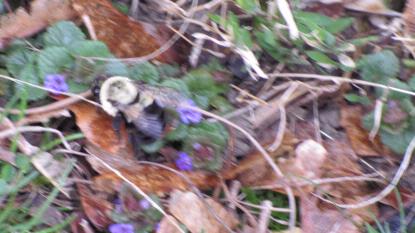The humble bumble
I stepped out this morning to attend to my chores. The indigent boarders let the chickens out these days, but don’t feed or water them. If you don’t water a chicken it’ll dry up and blow away in the wind. So one of my chores is to make sure there’s feed in the trough and water in the can. On my way back in I heard a rather loud buzz. This little lady was visiting some flowers behind my house.
Too bad the image is so wretched, but it turns out taking a picture of a bee is no easy feat. Especially when you’ve had three or four cups of strong coffee on an empty stomach. I hadn’t, but by the shaky image, you’d think I had.
This reminded me of several things. First the book Bumblebee Economics by Bernd Heinrich. Heinrich’s explanation of the invisible antenna of the marketplace is first rate. He also points out that most bumble bees are specialists. That is each insect will specialize in one or a few flowers. They know where the flowers are in the catchment area and they’ll head out each day to collect the sweet nectar. Furthermore, their nectar collection strategies are patterned and careful: they don’t visit the same flower again as they know it’s depleted.
The second thing it reminded me of is that a few recent stories in the journal Science have reported that a widely used insecticide may be the culprit for the bee die off that we’re experiencing. Neonicotinoids affect insect acetylcholine receptors, but not mammalian ones, so were deemed relatively safe. Safe for humans. But infinitesimal residual concentrations of the insecticide are confusing bees. They don’t get back to the hive. Moreover the queens aren’t reproducing as well. Here’s one report: http://www.huffingtonpost.com/2012/03/29/bees-neonicotinoid-pesticides-studies_n_1388385.html.
So I was happy to see the little blurry lady pollinating the damned weeds in my side-yard today. Would the chickens be smart enough not to eat a bumble bee? Don’t bet on it.
I stepped out this morning to attend to my chores. The indigent boarders let the chickens out these days, but don’t feed or water them. If you don’t water a chicken it’ll dry up and blow away in the wind. So one of my chores is to make sure there’s feed in the trough and water in the can. On my way back in I heard a rather loud buzz. This little lady was visiting some flowers behind my house.

Too bad the image is so wretched, but it turns out taking a picture of a bee is no easy feat. Especially when you’ve had three or four cups of strong coffee on an empty stomach. I hadn’t, but by the shaky image, you’d think I had.
This reminded me of several things. First the book Bumblebee Economics by Bernd Heinrich. Heinrich’s explanation of the invisible antenna of the marketplace is first rate. He also points out that most bumble bees are specialists. That is each insect will specialize in one or a few flowers. They know where the flowers are in the catchment area and they’ll head out each day to collect the sweet nectar. Furthermore, their nectar collection strategies are patterned and careful: they don’t visit the same flower again as they know it’s depleted.
The second thing it reminded me of is that a few recent stories in the journal Science have reported that a widely used insecticide may be the culprit for the bee die off that we’re experiencing. Neonicotinoids affect insect acetylcholine receptors, but not mammalian ones, so were deemed relatively safe. Safe for humans. But infinitesimal residual concentrations of the insecticide are confusing bees. They don’t get back to the hive. Moreover the queens aren’t reproducing as well. Here’s one report.
So I was happy to see the little blurry lady pollinating the damned weeds in my side-yard today. Would the chickens be smart enough not to eat a bumble bee? Don’t bet on it.
Related


